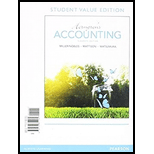
Horngren's Accounting, Student Value Edition Plus MyAccountingLab with Pearson eText, Access Card Package
11th Edition
ISBN: 9780134078946
Author: Tracie L. Miller-Nobles, Brenda L. Mattison, Ella Mae Matsumura
Publisher: PEARSON
expand_more
expand_more
format_list_bulleted
Concept explainers
Textbook Question
Chapter 14, Problem S14.4SE
Bond prices depend on the market rate of interest, stated rate of interest, and time.
Requirements
- Compute the price of the following 8% bonds of Allied Telecom.
- $500,000 issued at 75.50
- $500,000 issued at 102.75
- $500,000 issued at 96.50
- $500,000 issued at 102.50
- Which bond will Allied Telecom have to pay the most to retire at maturity? Explain your answer.
Expert Solution & Answer
Want to see the full answer?
Check out a sample textbook solution
Students have asked these similar questions
During the first month of operations, the following transactions were completed by ABC Corporation:
Dec 1 Issued 25,000 shares of $1 par common stock for cash of $23 per share.
Dec 3 ABC Company pays cash for Land and a building to be used in operations. The land cost $65,000 and the building cost $154,800.
Dec 4 Purchased $18,000 of store fixtures on account.
Dec 5 Purchased merchandise inventory from XYZ Company for $125,000, terms n/eom, FOB destination.
Dec 6 ABC sold $50,000 of merchandise on account, n/10, FOB shipping point. The cost of merchandise sold was $20,000.
Dec 9 Paid adverting costs of $20,000 to promote new business.
Dec 10 Purchased merchandise inventory from QRS Company for $100,000, terms n/30, FOB destination.
Dec 11 Purchased 500 shares of treasury stock for $17 per share.
Dec 12 ABC's Board of Directors declared a $30,000 cash dividend.
Dec 13 Paid $750 for utilities.
Dec 15 Paid cash dividends to common shareholders.
Dec 16 Received…
Provide answer
need help with this General accounting question
Chapter 14 Solutions
Horngren's Accounting, Student Value Edition Plus MyAccountingLab with Pearson eText, Access Card Package
Ch. 14 - Prob. 1QCCh. 14 - Daniels's bonds payable carry a stated interest...Ch. 14 - Prob. 3QCCh. 14 - Prob. 4QCCh. 14 - Prob. 5QCCh. 14 - Prob. 6QCCh. 14 - Prob. 7QCCh. 14 - Prob. 8QCCh. 14 - Prob. 9AQCCh. 14 - 10B Hicks Corporation issued S500.000 of 5%,...
Ch. 14 - Prob. 1RQCh. 14 - Prob. 2RQCh. 14 - Prob. 3RQCh. 14 - Prob. 4RQCh. 14 - Prob. 5RQCh. 14 - Prob. 6RQCh. 14 - Prob. 7RQCh. 14 - Prob. 8RQCh. 14 - Prob. 9RQCh. 14 - Prob. 10RQCh. 14 - Prob. 11RQCh. 14 - Prob. 12RQCh. 14 - 13. What type of account is Premium on Bonds...Ch. 14 - Prob. 14RQCh. 14 - Prob. 15RQCh. 14 - Prob. 16RQCh. 14 - What does the debt to equity ratio show, and how...Ch. 14 - Prob. 18ARQCh. 14 - Prob. 19ARQCh. 14 - Prob. 20ARQCh. 14 - Prob. 21BRQCh. 14 - Prob. S14.1SECh. 14 - Prob. S14.2SECh. 14 - Prob. S14.3SECh. 14 - Pricing bonds Bond prices depend on the market...Ch. 14 - Determining bond amounts Quick Drive-Ins borrowed...Ch. 14 - Journalizing bond transactions Piper Company...Ch. 14 - Journalizing bond transactions Ogden issued a...Ch. 14 - Journalizing bond transactions Watson Mutual...Ch. 14 - Journalizing bond transactions including...Ch. 14 - Retiring bonds payable before maturity On January...Ch. 14 - Preparing the liabilities section of the balance...Ch. 14 - Prob. S14.12SECh. 14 - Prob. S14A.13SECh. 14 - Determining the present value of bond at issuance...Ch. 14 - Using the effective-interest amortization method...Ch. 14 - Prob. S14B.16SECh. 14 - Accounting for long-term notes payable...Ch. 14 - Preparing an amortization schedule and recording...Ch. 14 - Analyzing alternative plans to raise money AF...Ch. 14 - Determining bond prices and interest expense Nooks...Ch. 14 - Journalizing bond issuance and interest payments...Ch. 14 - Journalizing bond issuance and interest payments...Ch. 14 - Prob. E14.23ECh. 14 - Journalizing bond issuance and interest payments...Ch. 14 - Retiring bonds payable before maturity Parkview...Ch. 14 - Prob. E14.26ECh. 14 - Prob. E14.27ECh. 14 - Prob. E14.28ECh. 14 - Prob. E14.29ECh. 14 - Prob. E14A.30ECh. 14 - A Journalizing liability transactions and...Ch. 14 - Analyzing, journalizing, and reporting bond...Ch. 14 - Analyzing and journalizing bond transactions On...Ch. 14 - Analyzing and journalizing bond transactions On...Ch. 14 - Prob. P14.35APGACh. 14 - Determining the present value of bonds payable and...Ch. 14 - Determining the present value of bands payable and...Ch. 14 - Journalizing liability transactions and reporting...Ch. 14 - Prob. P14.39BPGBCh. 14 - Prob. P14.40BPGBCh. 14 - Prob. P14.41BPGBCh. 14 - Prob. P14.42BPGBCh. 14 - Prob. P14.43BPGBCh. 14 - Prob. P14AB.44BPGBCh. 14 - Describing bonds and journalizing transactions for...Ch. 14 - Decision Case 14-1 The following questions are not...Ch. 14 - Ethical Issue 14-1 Raffle's Kids, a nonprofit...Ch. 14 - Prob. 14.1FCCh. 14 - Prob. 14.1FSC
Knowledge Booster
Learn more about
Need a deep-dive on the concept behind this application? Look no further. Learn more about this topic, accounting and related others by exploring similar questions and additional content below.Similar questions
arrow_back_ios
SEE MORE QUESTIONS
arrow_forward_ios
Recommended textbooks for you
 Excel Applications for Accounting PrinciplesAccountingISBN:9781111581565Author:Gaylord N. SmithPublisher:Cengage Learning
Excel Applications for Accounting PrinciplesAccountingISBN:9781111581565Author:Gaylord N. SmithPublisher:Cengage Learning

Excel Applications for Accounting Principles
Accounting
ISBN:9781111581565
Author:Gaylord N. Smith
Publisher:Cengage Learning

Bond Valuation - A Quick Review; Author: Pat Obi;https://www.youtube.com/watch?v=xDWTPmqcWW4;License: Standard Youtube License